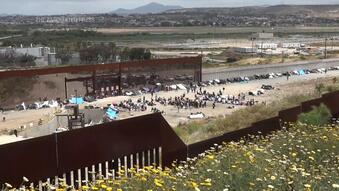Migrants rush across US border in final hours before Title 42 expires
5 min read
MATAMOROS, Mexico (AP) — Migrants rushed across the Mexico border Thursday in hopes of entering the U.S. in the final hours before pandemic-related asylum restrictions are lifted — a change that many feared would make it more difficult for them to stay.
With a late-night deadline looming, migrants in Mexico shed clothing before descending a steep bank into the Rio Grande, clutching plastic bags filled with clothes. One man held a baby in an open suitcase on his head.
On the U.S. side of the river, migrants put on dry clothing and picked their way through concertina wire. Many surrendered immediately to authorities and hoped to be released while pursuing their cases in backlogged immigration courts, which takes years.
It was not clear how many migrants were on the move, but a U.S. official reported that daily encounters on Tuesday hit 10,000 — nearly twice the level from March and only slightly below the 11,000 figure that authorities have said is the upper limit of the surge they anticipate after Title 42 ends.
“Our buses are full. Our planes are full,” said Pedro Cardenas, a city commissioner in Brownsville, Texas, just north of Matamoros.
President Joe Biden’s administration has been unveiling strict new measures to replace the restrictions known as Title 42. The outgoing rules have allowed border officials since March 2020 to quickly return asylum seekers back over the border on grounds of preventing the spread of COVID-19.
The new policies crack down on illegal crossings while also setting up legal pathways for migrants who apply online, seek a sponsor and undergo background checks. If successful, the reforms could fundamentally alter how migrants arrive at the U.S.-Mexico border.
But it will take time to see results. Biden has conceded that the border will be chaotic for a while. Immigrant advocacy groups have threatened legal action. And migrants fleeing poverty, gangs and persecution in their homelands are still desperate to reach U.S. soil at any cost.
William Contreras of Venezuela said Title 42 was good for people from his wracked South American country. He heard that many migrants before him were released in the United States.
“What we understand is that they won’t be letting anyone else in,” said Contreras’ friend, Pablo, who declined to give his last name because he planned to cross the border illegally. “That’s the reason for our urgency to cross through the border today.”
While Title 42 prevented many from seeking asylum, it carried no legal consequences, encouraging repeat attempts. After Thursday, migrants face being barred from entering the U.S. for five years and possible criminal prosecution.
Holding facilities along the border were far beyond capacity, and Border Patrol agents were told to begin releasing some migrants with instructions to appear at a U.S. immigration office within 60 days, according to a U.S. official. The official was not authorized to speak publicly about the matter and provided information to The Associated Press on condition of anonymity.
Agents were also told to start the releases in any area where holding facilities were at 125% capacity or the average time in custody exceeded 60 hours. In addition, releases could begin if 7,000 migrants were taken into custody across the entire border in one day.
More than 27,000 people were in U.S. Customs and Border Protection custody, the official said.
Homeland Security Secretary Alejandro Mayorkas warned of more crowded Border Patrol facilities to come.
“I cannot overstate the strain on our personnel and our facilities, but we know how to manage through such strain,” he told reporters Thursday.
He said the vast majority of migrants would be placed in “expedited removal” proceedings and would be expelled quickly if they don’t qualify to stay in the U.S.
“We have confidence in the lawfulness of our actions,” he said.
The stopping of about 10,000 migrants by the Border Patrol on Tuesday made for one of the agency’s busiest days ever, according to a second U.S. official who provided information to the AP on condition of anonymity because the official was not authorized to speak publicly about the matter.
The daily average was about 5,200 in March, according to the latest publicly available data.
On Thursday, about 400 migrants huddled in strong winds whipping up the sand on the bank of the Rio Grande east of El Paso as groups of Texas National Guard soldiers constructed concertina wire barriers.
A couple from Colombia approached the wire asking if they could start a fire because a 10-year-old was shaking in the desert cold. Most migrants huddled together under thin blankets.
Maj. Sean Storrud of the Texas National Guard said his troops have explained to migrants the consequences of crossing illegally.
“The migrants don’t really know what’s going to happen,” Storrud said.
Even as migrants were racing to reach to U.S. soil before the rules expire, Mexican President Andrés Manuel López Obrador said smugglers were sending a different message. He said there had been an uptick in smugglers at his country’s southern border offering to take migrants to the United States and telling them the border was open starting Thursday.
On Wednesday, Homeland Security announced a rule to make it extremely difficult for anyone who travels through another country, like Mexico, or who did not apply online, to qualify for asylum. It also introduced curfews with GPS tracking for families released in the U.S. before initial asylum screenings.
The administration considered detaining families until they cleared initial asylum screenings but opted instead for family curfews, which will run from 11 p.m. to 5 a.m. and begin soon in Baltimore, Chicago, Washington and Newark, New Jersey, according to a U.S. official who spoke on condition of anonymity because the information was not intended to be public.
Families who do not show up for screening interviews will be picked up by immigration authorities and deported.
At the same time, the administration has introduced expansive new legal pathways into the U.S.
Up to 30,000 people a month from Haiti, Cuba, Nicaragua and Venezuela can enter if they apply online with a financial sponsor and enter through an airport. Processing centers are opening in Guatemala, Colombia and elsewhere. Up to 1,000 can enter daily though land crossings with Mexico if they snag an appointment on an online app.
In San Diego, more than 100 migrants, many of them Colombian families, slept under plastic tarps between two border walls, watched over by Border Patrol agents who had nowhere to take them for processing.
Albino Leon, 51, said the end of Title 42 prompted his family to make the journey.
“With the changes they are making to the laws, it’s now or never,” said Leon, who flew to Mexico from Colombia and got past a first border wall to reach U.S. soil.






